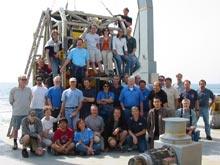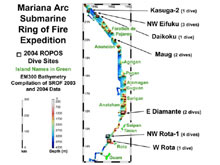
The Submarine Ring of Fire 2004 expedition science team and crew. Click image for larger view and more details.
An overall image of the Submarine Ring of Fire 2004 expedition. ROPOS dive sites are featured, overlaid on EM300 bathymetry data collected during the 2003 and 2004 expeditions. Click image for larger view.
Submarine Ring of Fire 2004: Mariana Arc Expedition Summary
March 30 - April 15, 2004
Bob Embley
Chief Scientist
Pacific Marine Environmental Laboratory
NOAA Vents Program
![]() View a video of high-resolution multibeam bathymetry collected on the 2003 and 2004 Submarine Ring of Fire expeditions (mp4, 7.9 MB).
View a video of high-resolution multibeam bathymetry collected on the 2003 and 2004 Submarine Ring of Fire expeditions (mp4, 7.9 MB).
Read the Final Cruise Report (15.9 Mb, PDF)
This was an extraordinary cruise, and we are only beginning to realize the importance of what we discovered over the past few weeks. Some of our initial observations and a sampling of the data we collected appeared on this Web site.
What made this cruise so different from many others we’ve collectively participated in? First, we had a great ocean-going science platform in the R/V Thomas G. Thompson. The multibeam sonar, the new Acoustic Doppler Current Meter, the dynamic positioning system, and many other instruments on the vessel were essential to the success of our sea-floor mapping and water-column measurements and samples. Second, we were fortunate to have the ROPOS remotely operated vehicle with its array of science tools and its talented operations team. ROPOS connected the science team directly to the sea-floor sites through its imaging and sampling systems.
Finally, the science team on this cruise was truly extraordinary. The participants' years of collective sea-going experience and their wide range of expertise were critical to effectively exploring the complex volcanoes of the Mariana Arc. Many a late night and early morning, I stood with my biologist, chemist, and geologist colleagues watching a new site unfold as the dive progressed, trying to construct a coherent framework to understand the images and other data pouring in from the sea floor below through the cameras and sensors on ROPOS. The day-to-day excitement and awe we experienced while looking at new phenomena reminded us of why we became scientists to begin with. We all feel very fortunate to have participated in this exploration of the Mariana volcanic arc.
Sign up for the Ocean Explorer E-mail Update List.




























